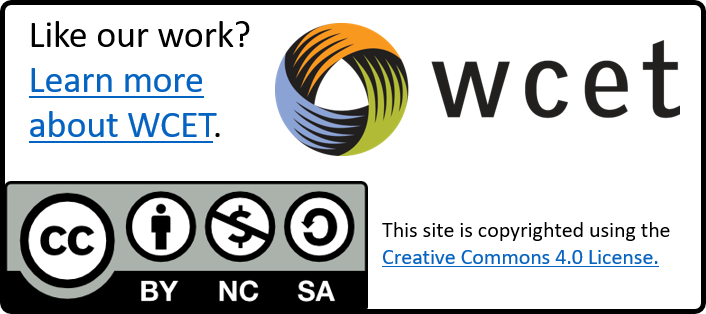Make Space for Innovation in Curriculum
Published by: WCET | 10/23/2019
Tags: Course Design, Innovation, Instructional Design, Professional Development, Student Success, Teaching, WCET Annual Conference
Published by: WCET | 10/23/2019
Tags: Course Design, Innovation, Instructional Design, Professional Development, Student Success, Teaching, WCET Annual Conference
Cleaning up….is definitely not my favorite activity. But, I understand a clean home and an organized workspace can be important for a healthy and effective life. Today’s guest author, Maria Andersen, the CEO of Coursetune, is here to discuss the importance of tidying up our curriculum, especially to make space for innovation in curriculum design.
Maria is one of the speakers at this year’s WCET Annual Meeting (she’s actually a pre-conference AND conference speaker, nice!). You can still register for the meeting in order to catch her great sessions!
Thank you Maria for this great post!
Enjoy the read and enjoy your day,
Lindsey Downs, WCET
For the last decade the learning analytics movement has pushed institutions to pay much closer attention to outcomes data, and most schools have made solid strides. We have various “nudging” plans and alert systems that closely monitor attendance-type data and ongoing success criteria (like assignment grades). And that’s great! Most institutions have improved graduation and retention rates with this type of data. However, I think we are running out of this “low hanging fruit” of data to monitor. We’ve mined it as much as we can. There is no choice now but to consider improvement of our curriculum to affect graduation and retention – and this means innovation.
There have been several successful initiatives to improve curriculum as a pathway to college completion. For example, in mathematics, the developmental math series is slowly fading out of existence on many campuses, replaced by initiatives like Quantways and Statways that help students complete college-credit math courses earlier in their educational journey. However, in many states (e.g. Florida, California) this curricular innovation was spurred by a legislative mandate. When financial aid for students is withheld if curriculum doesn’t change, this tends to force the curriculum change, like it or not.
How can we achieve innovation in curriculum without the heavy hammer of new laws? How do we create more relevant, streamlined, engaging curriculum on our campuses? In other words, how do we achieve innovation in curriculum through positive change?
Recently, I’ve been reflecting on the Marie Kondo movement to “tidy up your house” and I believe the lessons from this movement apply directly to curriculum.

People who “Kondo” their homes go through this process of piling up all the clothes, all the books, all the kitchen stuff (one type of item at a time) and then take a good look at what they have amassed. When you live in your home, it is hard to recognize through the slow accumulation over years and decades, just how much you’ve amassed. Many Kondo participants are so overwhelmed by their “stuff” that they just can’t seem to move forward in their lives. Releasing this burden of stuff makes the space in their lives to begin thinking about their actual lives again.
Curriculum experiences this same slow accumulation of “stuff” that Marie Kondo sees in homes. This happens through curriculum drift and curriculum bloat.
When a degree or certificate program is first designed, it has a careful alignment and scaffolding of concepts that students need to learn. Over the years we teach the curriculum, the world changes, adding new skills and technologies required by the workplace. Theoretically, we should be removing curriculum as we add new topics, but this is often done in a rushed fashion and results in curriculum drift. We add completely new topics to courses while holding on to everything (or almost everything) that was originally there. This is what I refer to as curriculum drift.
The other problem we see in curriculum is curriculum bloat. I use this phrase to specifically refer to the bloat of existing topics through the learning resources used to teach (textbooks and even OER materials). Publishers and authors go through revision cycles every couple years where they ask instructors all over the country to “review” the materials. Through this process, the authors and publishers discover missing knowledge, missing problem types, and ideas for modifying the texts (most often increasing them in size). We have been packing more and more chapters into the texts and also into the existing chapters and sections within those texts. Most instructors (especially the adjunct population) are handed the teaching materials and instructed to teach specific chapters (or the whole book). There is rarely a detailed set of instructions for which subsets of material to teach within a section of the text. The result is curriculum bloat.

As we run out of nudge and alert type solutions for improving student outcomes, the next wave of improved success rates must come from a critical examination and realignment of the curriculum we teach.
I believe a lot of curricular innovation fails because we don’t first look for space in the curriculum. We have usually taken the approach to innovate by first thinking about what else we want to add to an already overflowing set of courses. And most faculty look at the overstuffed closet of learning objectives and topics and just think “no way” can I shove one more thing in there.
What if we first “tidied up” our curriculum, making space where we can for innovation? I think this is the solution to successful innovation. Before we decide what to add, we need to decide what no longer belongs in what we teach today, and we need to do that up and down the courses required for the degree or certificate program.

We need to truly take stock of today’s curriculum by “piling it all up” and seeing what we actually have. Marie Kondo suggests that we thank items for the joy they brought us as we bag them up to leave our house. It’s time to do the same in our curriculum.
Are you heading to the WCET Annual Meeting in a few weeks? Join me for my session where we can continue the conversation on innovative curriculum!

Maria H. Andersen
CEO, Coursetune
coursetune.com
maria@coursetune.com
866.860.8863 x801

1 reply on “Make Space for Innovation in Curriculum”
[…] Carefully curated curriculum makes room for innovation and personalization. Dr. Maria Andersen, CourseTune CEO, published a guest article in depth on this topic last fall for WCET. Read the full article here. […]